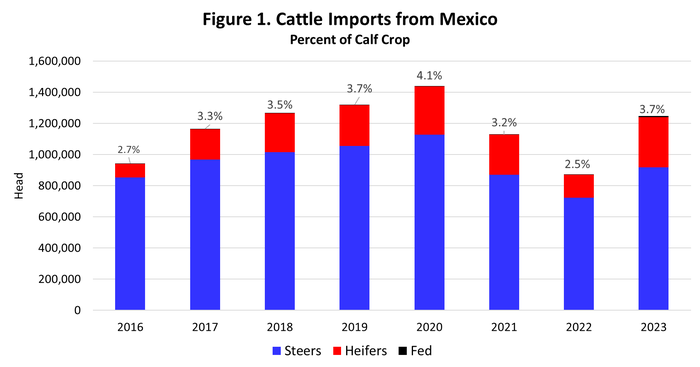Cattle imports from Mexico increasing
Last year, cattle imports from Mexico increased 43 percent over 2022.

U.S. cattle and beef trade with Mexico has evolved a great deal over many years. Mexico became one of the major beef export destinations about 25 years ago. In the last dozen years, Mexico has become one of the major beef import sources for the U.S. as beef trade evolved from simply supplementing deficit beef production in Mexico to bilateral, product specific trade between the two countries.
One of the oldest components of U.S. beef industry trade with Mexico has been the importation of live cattle. Mexico’s extensive range resources have provided the country with a comparative advantage in feeder cattle production for many years. Imports of Mexican cattle have averaged over 1 million head annually for the last 40 years. Figure 1 shows cattle imports from Mexico for the last eight years, which consisted of feeder cattle and just a handful of fed and breeding cattle. Feeder steers made up 80.7 percent of cattle imports with spayed heifers adding another 19.0 percent of total imports. Many of the Mexican cattle imports enter stocker programs in the U.S. prior to feedlot finishing, although some are placed in feedlots directly upon arrival in the U.S.

In 2023, imports of cattle from Mexico increased 43 percent year over year. However, the large percentage increase was in comparison to the very low level in 2022. Imports of Mexican cattle in 2022 were the lowest since 2008. Flows of Mexican cattle into the U.S. market vary from year to year because of numerous factors in both countries including relative cattle numbers and cattle prices; beef market conditions; drought; and currency exchange rates.
Figure 1 also shows the annual imports of Mexican cattle as a percent of the U.S. calf crop. It is common to talk about trade flows in absolute values which do not provide any perspective relative to the U.S. market. Imports of Mexican cattle have averaged 3.2 percent of the U.S. calf crop for the past 25 years, ranging from 1.9 to 4.3 percent. Finally, it should be noted that the U.S. does export some live cattle to Mexico, mostly breeding animals. For the past 25 years, an average of 43,000 head have been exported annually, making cattle exports about 4.3 percent of the level of cattle imports from Mexico. In 2022, over 103,000 head of cattle were exported to Mexico, the highest total since 2002.
About the Author(s)
You May Also Like


.png?width=300&auto=webp&quality=80&disable=upscale)
